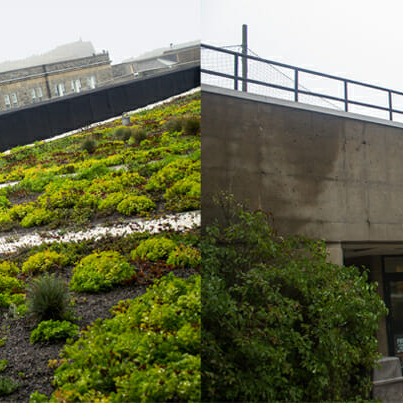
Dalhousie prides itself on being green, but how environmentally savvy are we really? Opinions Contributor Robin Tress takes a look.
The good
The Dal Student Union’s Sustainability Office (DSUSO) is a great place to look for success stories. In the three years of its existence DSUSO has pulled together annual Green Weeks, started a campus food garden with help from the university and with Nova Scotia Public Interest Research Group (NSPIRG) have created a bike sharing program for students. Rob MacNeish, policy and internal communications officer for DSUSO, says they have also begun research on starting to pull DSU investments from fossil fuel corporations. All in all, DSUSO has made huge strides in a short time.
The Dal Office of Sustainability, not to be confused with DSUSO, is in the business of making Dal greener as a whole. This office is responsible for seeking Leadership in Energy and Environmental Design (LEED) certification for buildings like the Mona Campbell, reducing Dal’s greenhouse gas emissions and running projects that encourage low-impact habit on campus. This office has numerous reports that quantify and cost out energy-saving measures around campus. For example, one report shows that the Killam Library could be saving 90 tonnes of carbon dioxide by switching to a solar air-heating system that would pay itself off in five to six years.
The College of Sustainability takes a holistic approach to sustainability education by teaching its students how to integrate sustainability into their lives, society and the workplace. Students learn concepts and challenges of sustainability, and class projects are more often than not based in real world changes to businesses and institutions. The College, now in its fifth year of existence, has upward of 500 students.
Students and faculty have been successful in putting together a heap of sustainability initiatives like clothing swaps, DIY workshops, how-to courses on reducing energy use, movie screenings and discussion groups, as well as presenting information on greening your home and workplace, like the Green Guide (greenguide.dal.ca).
The Bad
Thirty-four per cent of Dal students drive from home every day even though 75 per cent of us live within 10 kilometres of campus. Dal produces a lot of its own energy for heat and electricity using natural gas; while natural gas is less carbon-intensive than coal or bunker C, it still produces significant quantities of greenhouse gas, and requires unethical extraction procedures. More than half of students come from outside Nova Scotia, and many of them fly home at Christmas, Thanksgiving, reading week and in the summer. All in all, this is not a very ‘green’ place to start.
Despite innumerable reports written by students, faculty and independent consulting companies, Dal has managed to increase its greenhouse gas emissions by 4,000 tonnes from 2009 to 2012. Campus is still powered by fossil fuels. The LSC still sucks energy, not only from the heating and cooling, but from the souls of everyone within it. The dozens of houses that now serve as offices and mini-residences have abominable insulation.
The Ugly
On top of the aforementioned issues, Dal has an interesting relationship with many fossil fuel companies. The engineering department receives sponsorship from Shell. The geology department offers scholarships paid for by Petro-Canada and Chevron. The Canadian Association of Petroleum Producers is a member of Dal’s Critical Infrastructure Protection project. On top of that, many of Dal’s departments and faculties, and even the DSU, have investments in fossil fuel companies.
This leaves the university at a turning point. Dal must decide if it will continue to use its current model of operation, which includes support for the industry that is ravaging the people and environments of this planet, or if it will break free from the norm of inaction.
Moving forward
As a whole, we’ve started to turn a corner in our mindset and attitudes towards sustainability. We have the brains to ask tough questions and make big decisions. The variety of sustainability efforts has shown that. What we lack is the brawn. If we need to overcome apathy, roadblocks, and red tape to become more sustainable, if we need the university to cut ties with the fossil fuel industry, it’s up to the enlightened masses to stick together until those goals are achieved.







